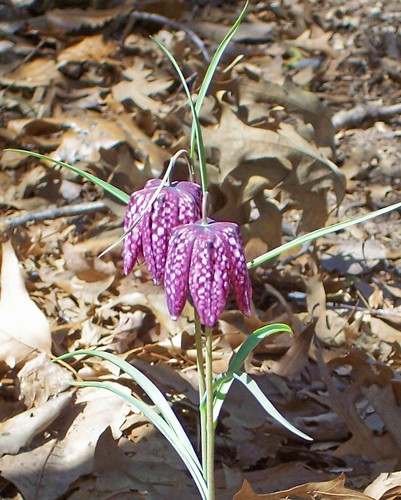To be filed under 'Odd Holidays': Fritillary Sunday, a moveable feast celebrated in Ducklington, Oxfordshire. Apparently this is simultaneously a celebration of a native wildflower and a fundraising event for the local CofE parish, St Bartholomew's. It appears to be of relatively recent invention, though I haven't found any definitive references to the first Fritillary Sunday.
A brief Googling brings up some references to fritillaries in the carvings, stained glass, and embroidered kneelers and altar cloths of the church, though no pictures of these artefacts. I'd be curious to see them, and know how old the carvings are. The church is predominantly 13th C. (See The Corpus of Romanesque Sculpture in Britain and Ireland page on Ducklington), but according to the parish's web site, the fritillaries weren't endangered until World War II, when the need for increased food production led to changes in farming which in turn destroyed habitat and plants. So did mediaeval sculptors carve those fritillaries? Were they added by some whimsical Victorian? Are they post-war, when people realised what they'd lost in fritillary population? Are they even there at all? The tour portion of the parish web site mentions the fritillaries in the sidelights of the south window (1934) but no carved fritillaries.
As a bonus point for pondering, there are butterflies called fritillaries, too. These are mostly members of the genus Speyeria and their cousins among the longwing (Heliconiinae) subfamily of the Nymphalidae. More on those at the Butterflies and Moths of North America site.
Fritillus is Latin for 'dice box' (now there's a piece of trivia for you); my guess is that both the butterflies and the flowers get the name Fritillary from being speckled. (Edit: Just checked the dictionary. I guessed right).
I didn't know of the existence of Fritillary Sunday before today -- I stumbled over it looking for some trivia about the flowers. I'd seen photos but hadn't seen an actual fritillary until I moved to St Andrews, where there were some planted under shrubs around the university library. They are such strange, somber little things that I fell in love with them at once, and when the Viking and I had a house with a proto-garden to call our own, I immeditely planted some. Of the dozen I planted only one has survived, but it's doing all right:

As it turns out, last Sunday was Fritillary Sunday, so I learned of it too late to do anything particularly festive. Given my remove from Ducklington, I'm not sure what I would have done beyond what I did, which was to spend a few happy moments sitting by my lone fritillary enjoying the spring sunshine.

No comments:
Post a Comment